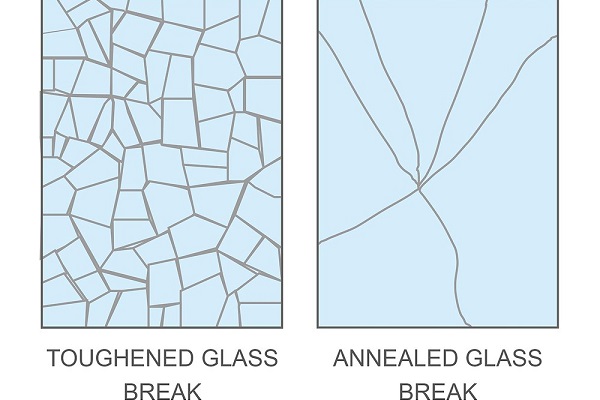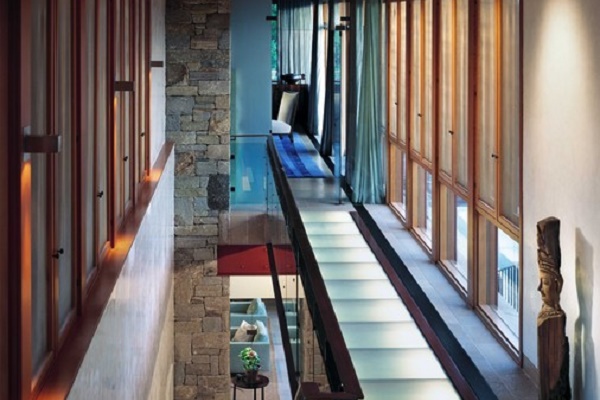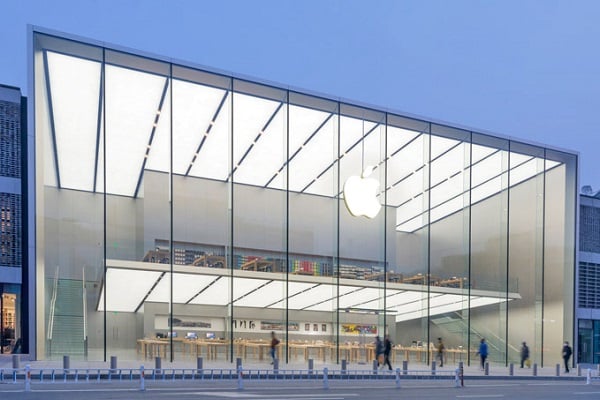


As designers and users, we have a constant battle between completely removing the inside or outside barrier and keeping homes safe. What if you can do both.
Can glass provide structural integrity and safety

Source: Glass House by Philip Johnson
When we think of glass, we think that it could shatter when it falls or on a strong impact. However, that's not entirely true. Today glass is used extensively in architecture, and not just for windows and fenestrations.
Safety glazing meets the Bureau of Indian Standards (BIS) conditions and come in two types that are preferred and commercially viable
a) Toughened Float Safety Glass (TF)
b) Laminated Float Safety Glass (LF)
Let's take a detailed look at toughened and laminated glass with their applications
Toughened glass or tempered glass is glass that has undergone processes of controlled thermal treatment to increase its strength. It is significantly stronger than normal annealed glass. Toughened glass properties also include the ability to handle greater temperatures and differentials, as well as fracturing into smaller pieces with blunt edges if the glass fails. This is why it’s often referred to as toughened safety glass.

This type of glass is used commonly in architecture. It finds its uses in multiple elements such as facades, load bearing members, fenestrations, staircases and railings, lifts, skylights, curtain walls, etc.

Source: Lookout Glass by Ike Kligerman Barkley
Laminated glass comprises two pieces of glass with a PVB interlayer. In the event of a breakage, this interlayer holds the glass in place so that shards of glass are not strewn around and cause injury.
The laminated glass will crack and break under sufficient impact, but the pieces of glass tend to adhere to the plastic and do not fly.
In case of a puncture, the edges are likely to be less jagged than that would be the case with ordinary glass. The interlayers work to support and hold the glass to create a strong, uniformed layer even when broken. It is generally used in places where human impact is possible or where the glass could fall and shatter.
Skylights and automobile windshields utilize laminated glass. In areas prone to hurricanes, laminated glass is often used in exterior storefronts, curtain walls, and windows.

Source: Apple Store, Hangzhou, China by Foster + Partners
Retaining the natural properties and characteristics of glass, laminated glass also comes in varying thicknesses and can be created using different glass combinations or coatings to provide different qualities, such as low emissions or increased insulation, allowing designs to be safe and sustainable.
These types of glass are not only safe to use as architectural components, but also strong and versatile, with the right treatment they can save energy and perform well to accommodate your design requirement. Manufactured in any shape, size and form, these tough and more importantly safe types of glass are a designers and users best friend.
What is toughened glass used for?
Toughened glass is used in various applications such as facades, partitions, staircases, railings, and skylights. It is preferred for these uses due to its increased strength and resistance to impact, making it a safer choice for areas that require durable materials.
How does laminated glass enhance safety?
Laminated glass consists of two layers of glass with a resilient PVB interlayer, which holds the glass in place even in an unlikely event of breakage.This feature significantly reduces the risk of injury from shattered glass, making it ideal for use in areas prone to impact, such as railing, facades, skylights and car windshields.
Can safety glass be customized?
Yes, different types of glass ranging from tinted, frosted, solar control, low-e etc can be toughened to enhance safety. Toughened glass can also be lacquered for use where opaque and vibrant glass applications are desired. Glass must be cut to desired shapes and sizes before the toughening process.
Is safety glass suitable for energy-efficient designs?
High performance glass can be toughened to enhance Safety improving energy efficiency of buildings, making it an excellent choice for sustainable architectural designs. By enhancing insulation and reducing energy consumption, it helps create more comfortable and environmentally friendly living spaces.
An Architect, a writer, a traveler, a photographer and much more, Shivani Chaudhary is, among all, an Architectural Journalist, trying to bridge the gap between the architectural community and the world. Read More